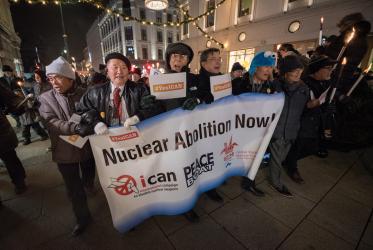Hiroshima, 6 August 2015 - What sights and sounds told this city’s story today? A graveside scream at dawn? The penetrating gong that sounded to mark the moment the atomic bomb exploded 70 years ago? Candle lanterns floating toward the sea on the evening tide? Or a young pastor’s confession, “I feel guilty”, because his family was spared 70 years ago by a last-minute twist of fate?
Members of the World Council of Churches pilgrimage for the 70th anniversary of the atomic bombings spent this day of commemoration with Japanese churches, people of other faiths, local citizens and visitors from around the world.
What happened to Hiroshima still hangs over the city, with emotion, especially on a day like today. In the early morning, a monk cried out to the heavens during a multi-religious ceremony at a mound where the ashes of 70,000 people are buried. The gong at 8:15 a.m. reverberated outward through a crowd of tens of thousands and echoed off surrounding skyscrapers. Each floating lantern on the river this evening was lit for a life that was lost on 6 August 1945, or the even greater number of people who have died from the long-term effects in the decades since. The young pastor’s hometown is Kokura, Japan, the original target for the second atomic bomb attack. When clouds began to obscure the city, the approaching American bomber was told to go to Nagasaki instead.
Bishop Mary Ann Swenson of the United Methodist Church placed flowers at the Hiroshima cenotaph this morning. She said it reminded her of laying flowers at a memorial to the Armenian genocide recently. “A deep sadness came over me that my country had done this to Japan,” she said. “Yet it means so much on this day that people from all over the world are here speaking out about their shared resolve to get rid of nuclear weapons.”
The ecumenical pilgrims here come from two countries that have nuclear weapons – the United States and Pakistan – and five countries that profess support for nuclear disarmament while continuing to accept their protection.
Rev. Dr Sang Chang reminded an inter-religious seminar that all other Weapons of Mass Destruction have been banned, “Yet the most destructive of all weapons – nuclear weapons – has not been banned,” she said. This legal gap must be closed, she said, and “a new Humanitarian Pledge is providing a pathway so that solution-minded states can join in closing that gap together.” 113 states have now endorsed the pledge. “All governments must be urged to do the same,” said Chang, the WCC Asia President and a Presbyterian leader from South Korea.
Bishop Heinrich Bedford-Strohm, a Lutheran leader from Germany, told the 70th Anniversary Hiroshima Day Rally, “We must refuse to accept that the mass destruction of other peoples can be a legitimate form of protection for ourselves.”
Archbishop Nathaniel Uematsu of the Anglican Church in Japan asked the delegation to “take what they are seeing back to your own countries, explain why Christians must reject nuclear weapons, and be witnesses for our sake.”
The pilgrims’ home countries are close at hand in one sense. There have been frequent interviews with media in Germany, the Netherlands, Norway, the United Kingdom and the United States.
After the 70th anniversary commemorations in Nagasaki on August 9th, the church leaders will go home to talk to their own governments about what happened in Hiroshima and Nagasaki, ask why they are still prepared 70 years later to destroy hundreds of cities in similar fashion, and to urge them to join the new international Humanitarian Pledge to close the legal gap that nuclear weapons still enjoy.
During today’s observances, the mayor of Hiroshima invited President Obama and other world leaders to meet in his city next year, see for themselves, and start negotiations on a legal ban.





